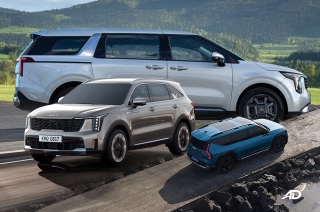
You’ve already probably heard the line that high-octane fuel can clean your car’s engine or can boost performance from TV ads, your dad, or your grandfather. Aside from those, some even claim to give better fuel efficiency. These are just a few of the persistent myths drivers believe. But are any of them actually true? Today, we’re digging into the facts to find out and separate myth from reality. Let the mythbusting begin!
Myth 1: Higher octane fuels produce more power

Sadly, 95 octane fuel isn’t any more powerful than your regular 91 octane gasoline. To explain why, let’s briefly talk about what octane ratings measure.
Octane isn’t a measure of how powerful a fuel is, it measures how the fuel behaves under pressure. Specifically, it indicates how likely the fuel is to combust in a controlled, predictable way during the engine’s compression stroke. The higher the octane rating, the more stable the combustion under high pressure.
This stability also means that 95 octane is less “excitable” than 91 octane, making it chemically less prone to premature combustion (also known as "knocking"). From a chemical energy perspective, it's not more powerful, just more stable. That stability is where high-performance engines get the most benefit.
If you’ve ever browsed car brochures, you’ll notice that most everyday economy sedans typically recommend 91 octane fuel. Sometimes, manufacturers only mention this in the owner’s manual. But when you move up to the high-performance end of the spectrum, brochures often state that the engine’s advertised power output is achieved with 95 octane fuel, and they’ll clearly specify to use only 95 octane.
That’s because high-performance engines are designed with higher compression ratios. To support this, they require a more stable fuel, like 95 octane, to avoid knocking. It’s the increased compression inside the cylinder that produces more power, not the fuel itself. Octane doesn’t create more power; rather, it enables the engine to run more aggressive tuning, including higher compression and advanced ignition timing. And it’s this tuning that results in greater engine performance.
Myth 2: Higher octane fuels can clean the engine of carbon deposits

Another myth you’ve likely heard from your elders is that high-octane gasoline will “clean” the engine of carbon deposits, making it run better. This is simply false. In reality, it's not the octane rating that does the cleaning, it's the additives blended into the fuel. Most high-quality fuels, regardless of octane, include detergents designed to keep the fuel system clean. Keeping your engine in top shape depends more on regular maintenance, like using the right oil and sticking to service intervals, than on choosing a higher octane rating.
Buying high-octane fuel is not an alternative to regularly changing your oil. Just stay on top of your service intervals and believe us, your engine will remain spick and span.
Myth 3: Low-octane fuel can damage your engine
This myth can be true or false, depending on your car. If you’re driving a modern vehicle with a factory-tuned engine, using the octane rating recommended by the manufacturer is safe and won’t harm your engine. Most modern engines are equipped with knock sensors that adjust ignition timing to prevent knock, so using a lower-octane fuel than recommended may not cause immediate damage or any damage at all, but it can reduce performance and fuel efficiency. However, if the engine is already experiencing knocking and you continue to use the wrong octane fuel, continuing to drive it will only exacerbate the issue.
However, if you drive a performance car designed to run on higher-octane fuel (e.g., 91 to 93 AKI or 95 to 98 RON) and use a significantly lower-octane fuel instead, you may be putting your engine at risk. High-performance engines usually have higher compression ratios and more aggressive ignition timing, which makes them more susceptible to knock, a condition where the fuel-air mixture ignites prematurely under high pressure and temperature.
While modern knock sensors can often compensate, prolonged use of lower-octane fuel in a high-octane engine can lead to degraded performance, efficiency losses, and potentially long-term engine damage. Older engines without knock sensors are even more vulnerable to knock-related damage, which is why it’s essential to follow your vehicle manufacturer’s octane recommendations.
Myth 4: High-octane fuel improves fuel efficiency
False. In reality, unless your engine is specifically engineered to take advantage of higher-octane fuel, you're unlikely to see any improvement in mileage or performance. Using premium fuel in an engine designed for regular octane (such as 87 AKI or 91 RON) can sometimes result in lower fuel efficiency. As mentioned earlier, high-octane fuel doesn’t contain more energy, it simply resists knocking better by being more stable under high pressure and temperature. Using higher-octane fuel in an engine that doesn’t need it may lead to less efficient combustion timing, which can reduce overall efficiency instead of improving it.
Myth 5: High-octane fuel is always “better” for your car

Once again, saying “Better” is relative to what your engine actually needs. If your car is designed to run on 87 RON octane, using 91 or 95 RON will not make it perform better, run smoother, or live longer. In fact, using higher-octane fuel unnecessarily just makes you spend more at the pump with no real or discernible benefit.
Manufacturers specify the octane rating based on the engine's compression ratio and tuning. Following the recommended octane in your owner's manual ensures your engine gets the right fuel for optimal performance, efficiency, and longevity, without wasting money. Plus, if you’re worried about fuel gumming up the works in your engine, ignoring your service intervals and not changing dirty oil can do far worse than using regular gasoline.
Next time you’re at the pump, just remember that the most expensive fuel you can get is not always the best. Follow your owner’s manual, and your car will run smoothly, and your wallet will even thank you.
If you’re looking to buy a new ride, or a high-performance car that actually needs high-octane fuel, check out the AutoDeal Car Guide and browse the current and latest cars on sale in the Philippines.
Latest Features
-
An all-electric future: The Porsche Macan Electric / Featured Article
Porsche’s Macan goes all-electric; it’s a new beast with an electrified heart, yet unmistakably Porsche in performance and spirit.
-
Which Kia should I buy? / Featured Article
We’re here to help you decide which Kia vehicle is best for you, whether it’s a sedan, crossover, or minivan.
-
Why Lynk & Co is a good option for luxury car buyers / Featured Article
Lynk & Co offers premium value for those exploring the luxury market.
Popular Articles
-
Electric Vehicles in the Philippines for under P1 million
Jerome Tresvalles · Aug 19, 2025
-
Top 3 Cars For Every Lifestyle—What Cars Are Right For You? | Behind a Desk
Caco Tirona · Apr 24, 2024
-
5 Tips to Maximize Fuel Efficiency
Jerome Tresvalles · Sep 09, 2024
-
Five driving habits that are draining your fuel tank
Jerome Tresvalles · Jun 24, 2025
-
Can engine braking harm your engine?
Jerome Tresvalles · Sep 11, 2025
-
Do electric cars even need maintenance?
Jerome Tresvalles · Oct 23, 2024
-
Best vehicles for an active outdoor lifestyle
Shaynah Miranda · Jul 25, 2024
-
How to drive different types of vehicle transmissions
May 23, 2024
-
5 easy ways to keep your car interior clean
Allysa Mae Zulueta · Nov 15, 2021
-
How to survive Metro Manila traffic
Earl Lee · Aug 16, 2022




